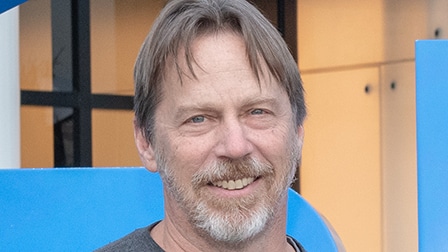Some time ago we published an article about Lisa Su, current CEO of AMD, illustrating her career and calling her "the woman who raised AMD". The term "revive" has sparked a healthy debate about the role of the CEO, executives and designers. It seems almost superfluous to have to write it, but it is clear that we did not mean that all the credit should be ascribed to Lisa Su, or to a single person, but we are also convinced that the good performance of a company is the result of many components, including those sets a clear strategy and manages to keep the bar straight in one direction.
Speaking of people who played an important role in AMD's comeback, the name of (rightly) emerged Jim Keller. Those who have been passionate about hardware for years know that we are talking about a central figure for the world of computing architectures, while others may not know him, know what he has done in the past and what he is currently dealing with. We are therefore pleased to dedicate a few lines to an engineer who has repeatedly had a impact in our lives of technological users and that is preparing, we are sure, to leave a mark again.
The career, from DEC to Tesla, passing twice through AMD
Jim Keller's private life is almost completely secret, practically nothing is known and perhaps it is right so since we are talking about an engineer. We know that has two children and loves kitesurfing, snowboarding and running, as well as the pilot. So little has been written and said about Keller that there is not even a clear birth date: in a 2012 release there was talk of 53 years, so he should have been born in 1959. As for studies, the only known detail is that he holds one electrical engineering degree from Penn State University.
However, his career path is what interests us most and in this regard we know that Keller has worked for DEC (Digital Equipment Corporation) until 1998, where he was involved with the role of "corporate consulting engineer" in the design of the RISC Alpha 21164 and 21264 processors.
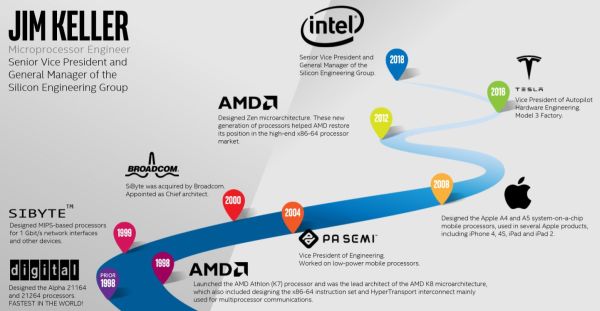
Click to enlarge
It was in 1998, when DEC was acquired by Compaq, that Keller found a new home in AMD, working on two architectures that we still remember well, K7 and K8. The latter, in particular, saw him implicated in the role of chief architect, and it is important because it was the first to support 64 bits. Keller also helped develop the interconnection HyperTransport, of particular importance for efficiently connecting multiple processors on multi-socket platforms.
The K8 architecture in and of itself may not tell you anything, but if you've been using your PC for a few decades, then names like AMD Athlon 64, Athlon 64 X2, Athlon 64 FX, Opteron 64 and Turion should tell you something. The K8 processors debuted in 2003 and put Intel and the Pentium IV processors, then the main competitors, in serious difficulty, offering competitive performance at more favorable prices, without forgetting a better consumption profile and temperatures (especially if compared to "Prescott"by Intel).
The first Athlon 64 processors were compatible with socket 754, had a single core and were produced with a 130 nanometer process. Over the years it went first to 90 and then to 65 nanometers, and from 1 to 2 cores, with two jumps of sockets: first socket 939 and then AM2. The era of multi-core CPUs was therefore opening. Code names like Clawhammer, Venice, San Diego, Newcastle, Windsor and Toledo we are sure many old fans will come back to mind. Frequencies grew to 3.2 GHz on the dual-core Athlon 64 X2 6400+ – NOTE: were years in which Intel believed it could reach 10 GHz in a short time.
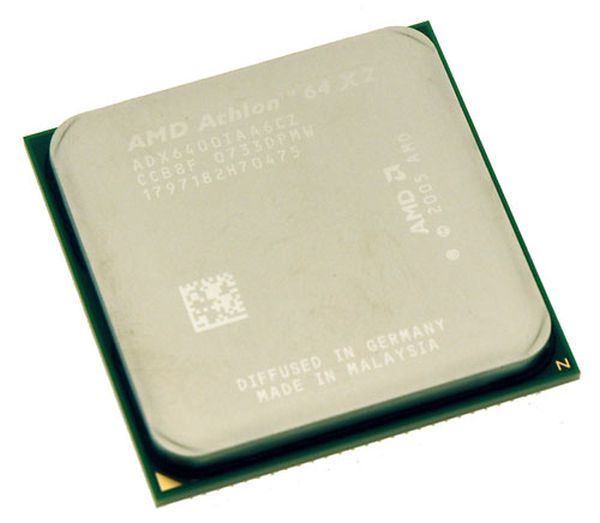
The processors of the time were characterized by an abbreviation, the so-called Performance Rating, initially created to represent an equivalence in terms of power with the Intel CPUs instead of indicating the actual clock frequency. This was due to the fact that for all Intel was the de facto industry standard, the touchstone. Basically an Athlon 64 2000+, based on equivalence, should have offered similar performance to a 2 GHz Pentium, and so on. Over time that number lost its meaning altogether.
Among the features that made K8 architecture stand out we had the memory controller integrated in the processor die: operating at the same frequency of the CPU and with less road to follow for the electrical signals, the latencies of access to the memory were much more contained. Better support for SSE instructions, wider Translation Lookaside Buffers and improved IPC performance rounded off the circle, cornering the Pentium IV.
It can therefore be said that the processors designed by Keller (and his team) accompanied the technological life of many readers with a few years on their shoulders. In 1999 Jim Keller left AMD to move to SiByte, focused on the design of MIPS processors for network interfaces and other devices. SiByte was acquired in November 2000 by Broadcom, where Keller continued to work as chief architect until 2004.
In 2004 it became Vice President of Engineering by P.A. Seeds, a small company specializing in the design of low consumption mobile processors based on ARM architecture. Just before P.A. Semi was bought by Apple to start the design of internal SoC, Keller went right to the house in Cupertino, where contributed to the design of the Apple A4 and A5 chips, used in various products such as iPhone 4, 4S, iPad and iPad 2.
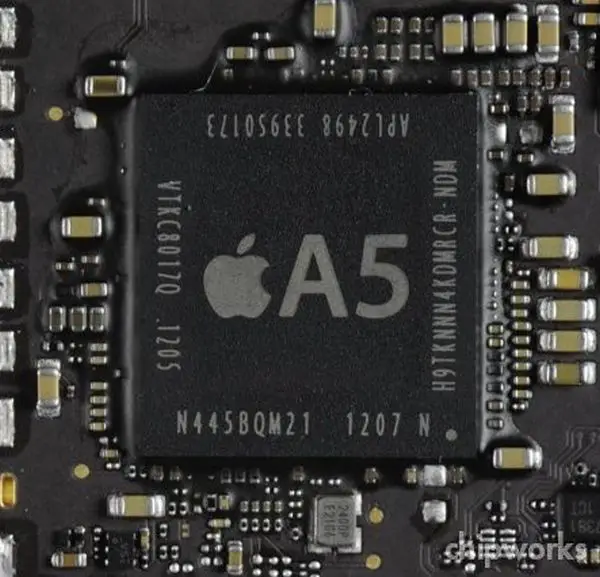
The experience gained by Keller in the field of MIPS and ARM architectures we can say that was the icing on the cake of a complete engineer from all points of view: he has skills in the development of high-performance cores as well as in low-consumption cores, but in General likes to call himself "computer, artificial intelligence and SoC expert. I know a lot of GPUs and software stack, I have worked on network processors, transistors and production processes". A figure that all companies would like to have and their own what AMD needed to recover after difficult years, whose genesis you may want to learn more by reading the article dedicated to Lisa Su.
After the excellent performance in the first part of the 2000s, from 2006 onwards a slow and inexorable decline began for AMD, due to several factors, including architectures: from the K10 architecture of the Phenoms to the Bulldozer and subsequent evolutions – Piledriver, Steamroller – of the FX CPUs, for many years AMD was no longer able to compete at the top with Intel, which thanks to the Core architecture (Conroe and subsequent evolutions) managed to return to the command of the sector.
It will be fate, it will be what it will be, but in August 2012 Keller returned to the ranks of AMD to revive its ambitions in the field of high performance architectures. Some saw it as a "Prodigal Son", demonstrating the fact that behind his first experience in AMD he had built a real mythological figure, like a David who managed to stand up to Goliath.
The initial idea was to create two architectures, an x86 and an ARM. The first idea evolved inZen architecture of Ryzen processors, which arrived on the market in 2017, five years after Keller's return. The K12 project was canceled, as after a timid attempt called the Opteron A1100, AMD became aware that the ARM architecture in the desktop and server environment would not give the hoped for returns in a short time. ARM still hasn't made it to the market today, although ambitious and interesting projects are not lacking.
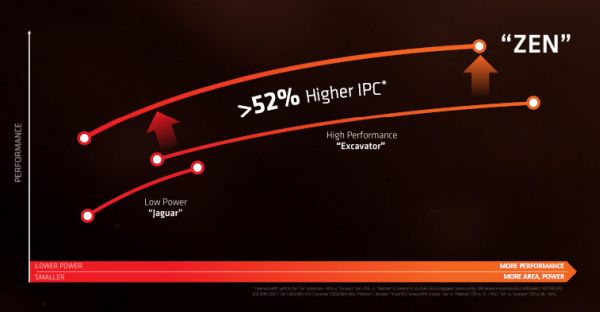
As for Zen, we don't need to tell you about the last three years of AMD, with the three generations of Ryzen CPUs seen so far and a fourth on the horizon. Just think that Zen is a completely new architecture compared to previous Bulldozer based solutions, and is capable not only of scaling to offer a high number of cores, but also of guaranteeing a high IPC – performance per clock cycle – high: AMD it was able to increase it by 52% by switching from Steamroller to Zen.
The Ryzen 1000s were at the level of the Intel Core models of the 7000/8000 series, but the subsequent evolutions of the Zen architecture and the improvements in the design and production process led us to have an AMD ahead of Intel today on several aspects. The "second coming" of Keller in AMD can therefore be considered yet another great success story.
Keller left AMD for the second time on September 18, 2015, after practically completing the work on Zen, for join Tesla in January 2016 as Vice President of Autopilot Hardware Engineering where he led the development of an artificial intelligence chip destined to make Elon Musk's electric cars increasingly autonomous. And while everything suggested that we would never see Keller involved in the PC sector again, here comes an unexpected announcement: April 2018, Keller joins the ranks of Intel. Yes, the Intel one that Keller has helped to put in trouble twice.
Intel is focusing on Keller for the future
The arrival of Keller in the Intel workforce shook a bit all fans. In Italy we are used to thinking often in terms of flags, as in football, and the passage of designers between AMD and Intel and vice versa seems almost "scandalous" to us. In the United States the market is much more liquid and people of the caliber of Keller move both in front of a good economic price, but also if they are given the opportunity to work on ambitious projects.
Questioned by HPCwire, Keller explained that he joined Intel for "a couple of reasons": the first was the scope of the opportunity and the impact of the company in the world, the second the possibility of working with other people passionate about technological innovation, interested in doing great things. But most everything Keller loves to work on complex problems. "I go into the details of what I am doing and I worry about what the results of my project are, whether they are positive or negative. Details and problems inspire me. You learn more from mistakes than from successes".
Jim Keller is senior vice president of "Technology, Systems Architecture and Client Group" (TSCG) and general manager of the Silicon Engineering Group (SEG). In his biography on Intel's corporate website it says that it is "responsible for the engineering organization of silicon within the TSCG"What does this mean? Who works in the round, playing a much more complex role than those covered in the past: packing technologies, architectures and everything you need to make silicon transform into a project capable of changing people's lives. Not the work, albeit decidedly not simple, on an architecture, but the possibility of affecting the development and design of a product at various levels.
An assignment that requires coordinating several teams towards a single goal. So Keller will certainly have said yes to a great opportunity from all points of view, but he has taken on a not indifferent commitment, full of challenges. His work, in our opinion, is not the simplest, there is no immediate gratification, there is talk of projects that are thought of years before they reach the market. Understanding what will be suitable for the needs of the market in 5 years, taking into account also what the competition could do, does it seem easy to you? To us for nothing.
Landing in Intel, Keller has entered in a framework of designers that reminds us very much of an NBA team, with names of the caliber of Mike Mayberry, Raja M. Koduri and Venkata (Murthy) Renduchintala who have a long experience in the field of architecture, of all kinds. Among other things, it must be said that Koduri is another important figure in the history of AMD, where he worked on multiple graphic projects (also of the then ATI Technologies). Koduri was certainly a great facilitator for Keller's arrival in Intel.
Despite the difficulties related to the delay in the transition to the 10-nanometer production process, the US company has all the resources to bring great innovations in the technological sector, starting from the packaging technologies and related solutions: EMIB, Foveros, Co- EMIB, Omni-Directional Interconnect (ODI) and M-DIO are just a few abbreviations on which you can research and which we will investigate in the future.
Keller and the "Moore's Law"
In the field of processor design and production, the "Moore's law"It has represented a cornerstone for decades. Postulated by Intel's co-founder Gordon Moore, he says that the" number of transistors in an integrated circuit doubles every two years. "It is not a real law, but it has taken this name because it has proved valid long. In recent years, many have a slowdown in the miniaturization of transistors has been identified and for this reason they have declared their death. Jim Keller has a totally different opinion.
"My observation is that the end has always been near, but there have always been and there will be new things we can do to keep putting off the end. The real challenge is: what happens as we continue to downsize technology? Which new architecture do we need and how do problems change? This is the interesting point, "he said in an interview. "Moore's law is unstoppable. I'm not picky about Moore's law that only talks about smaller and smaller transistors – I'm interested in the technological trends, physics and metaphysics that surrounds us. Moore's law is a collective illusion shared by millions of people".
Keller therefore believes that making smaller and smaller transistors today is only part of what must be defined as "Moore's Law": new architectures, the evolution of EUV lithography, nanowire-based transistors and new packaging solutions will all contribute to cram transistors 50 times more densely than possible today. "What I want to do is create faster computers", added Keller. We sincerely hope that he will, as he always has.
To see the fruits of his work it takes time, new technologies and architectures are not developed overnight. We are convinced, however, that Intel has made a good choice by relying on Keller, its curriculum precedes it. Of course, there can always be a setback, but with the firepower of Intel behind it, it has everything it needs to win this challenge too.





